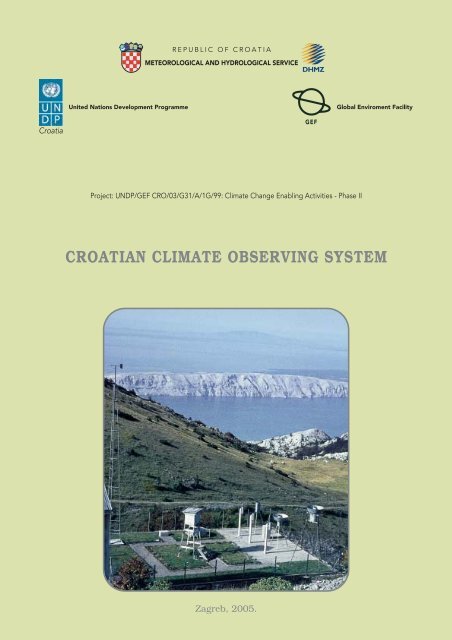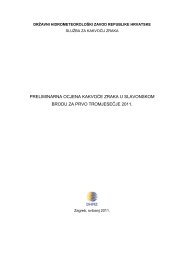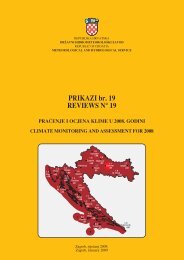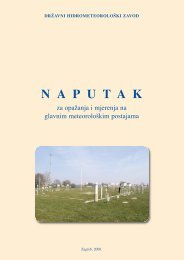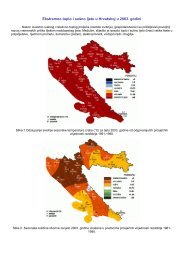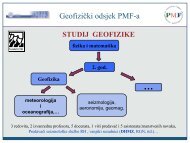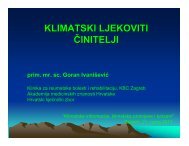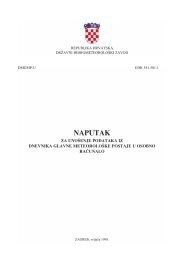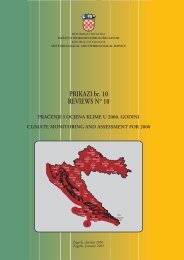CROATIAN CLIMATE OBSERVING SYSTEM
CROATIAN CLIMATE OBSERVING SYSTEM
CROATIAN CLIMATE OBSERVING SYSTEM
You also want an ePaper? Increase the reach of your titles
YUMPU automatically turns print PDFs into web optimized ePapers that Google loves.
REPUBLIC OF CROATIA<br />
METEOROLOGICAL AND HYDROLOGICAL SERVICE<br />
United Nations Development Programme<br />
Global Enviroment Facility<br />
Croatia<br />
GEF<br />
Project: UNDP/GEF CRO/03/G31/A/1G/99: Climate Change Enabling Activities - Phase II<br />
<strong>CROATIAN</strong> <strong>CLIMATE</strong> <strong>OBSERVING</strong> <strong>SYSTEM</strong><br />
Zagreb, 2005.
REPUBLIC OF CROATIA<br />
METEOROLOGICAL AND HYDROLOGICAL SERVICE<br />
United Nations Development Programme<br />
Global Enviroment Facility<br />
Croatia<br />
GEF<br />
<strong>CROATIAN</strong> <strong>CLIMATE</strong><br />
<strong>OBSERVING</strong> <strong>SYSTEM</strong><br />
Capacity building for participation in systematic<br />
observation networks in Croatia<br />
Zagreb, November 2005.
PROJECT<br />
UNDP/GEF CRO/03/G31/A/1G/99: Climate Change Enabling Activities - Phase II<br />
COMMISSIONED BY<br />
The Ministry of Environmental Protection, Physical Planning and Construction<br />
PUBLISHED BY<br />
The National Meteorological and Hydrological Service (MHS)<br />
MANAGING EDITOR<br />
Ivan »aËiÊ, Director MHS-a<br />
EDITOR IN CHIEF<br />
Zvonimir Katuπin<br />
TRANSLATED BY<br />
Valnea Bressan<br />
GRAPHIIC DESIGN<br />
Ivan Lukac<br />
COMPILATION<br />
Ivan Lukac<br />
TISAK:<br />
The views expressed in this publication are those of the authors and<br />
do not necessarily represent those of UNDP<br />
CIP - Katalogizacija u publikaciji<br />
Nacionalna i sveuËiliπna knjiænica - Zagreb<br />
UDK 551.501(497.5)<br />
KATU©IN, Zvonimir<br />
Croatian climate observing system :<br />
capacity building for participation in<br />
systematic observation networks in Croatia<br />
/ . - Zagreb :<br />
The National Meteorological and Hydrological Service, 2005<br />
Izv. stv. nasl.: Hrvatski klimatski<br />
motriteljski sustav : razvijanje moguÊnosti<br />
za provoappleenje motrenja u sustavnim motriteljskim mreæama<br />
klimatskog sustava Republike Hrvatske<br />
ISBN 953-96631-7-2<br />
I. Meteoroloπka mjerenja -- Hrvatska<br />
II. Klimatske promjene -- Meteoroloπka mjerenja<br />
451128161<br />
Front cover ilustration: main meteorologocal station Zaviæan (1594 m), MHS
C O N T E N T<br />
Preface ......................................................................................................................... 5<br />
1 Introduction ..................................................................................................... 7<br />
2. Global Climate Observing System ..................................................................... 7<br />
2.1 Global Climate Observing System - purpose and tasks ..................................... 7<br />
2.2 GCOS at global, regional and national level, and GEOSS................................. 10<br />
3. GCOS Climate monitoring principles .............................................................. 10<br />
4. Assessment of the current status of national climate observing programmes... 12<br />
4.1 Atmospheric Domain - station types and number, activities and organisation . 12<br />
4.1.1 Surface stations - activities and organisation ................................................. 13<br />
4.1.2 Upper-air stations - activities and organisation ............................................... 17<br />
4.1.3 Atmosphere-composition stations, activities and organisation ........................ 18<br />
4.2 Oceanic Domain - station types and number, activities and organisation ....... 19<br />
4.2.1 Ship meteorological observations, activities and organization ......................... 20<br />
4.2.2 Sea surface temperature, activities and organisation ...................................... 21<br />
4.2.3 Sea level, activities and organisation .............................................................. 21<br />
4.2.4 Sea state (waves), activities and organisation ................................................. 21<br />
4.2.5 Oceanographic observations in situ ................................................................. 21<br />
4.2.5.1 In situ coastal automatic oceanographic and meteorological stations ............. 21<br />
4.2.5.2 In situ moored-bouy automatic oceanographic and meteorological stations .... 21<br />
4.2.6 Research ship observations, description and organisation .............................. 21<br />
4.3 Terrestrial domain - station types and number, activities and organisation .... 23<br />
4.3.1 Hydrology, activities and organisation ............................................................ 24<br />
4.3.2 Glaciology, activities and organisation ............................................................ 25<br />
4.3.3 Soil and vegetation, activities and organisation .............................................. 26<br />
5. Space-based (satellite) observation programme ............................................... 27<br />
5.1 Space-based observation programmes used in Croatia and<br />
Croatia's participation in related international programmes ........................... 27<br />
6. Observing system deficiencies in Croatia ........................................................ 29<br />
6.1 Atmospheric domain ...................................................................................... 29<br />
6.2 Oceanic domain .............................................................................................. 29<br />
6.3 Terrestrial domain .......................................................................................... 29
6.4 Space-based observations - space (satellite) programmes ............................... 29<br />
7. Difficulties met by the climate observing systems in Croatia ........................... 30<br />
7.1 Main difficulties .............................................................................................. 30<br />
7.2 Institutions responsible for the different climate system networks in Croatia . 30<br />
7.3 Observations performed under different authority (institutions) in Croatia ..... 31<br />
a) National Meteorological and Hydrological Service ........................................ 31<br />
b) Ministry of the Sea, Tourism, Transport and Development<br />
(airports and road traffic) ............................................................................... 32<br />
c) Ministry of Environmental Protection, Physical Planning<br />
and Construction (Environmental Protection Agency) ..................................... 32<br />
d) Ministry of Health and Social Welfare<br />
(Medical Research Institute and Public Health Institute) ................................. 33<br />
e) Institute of Oceanography and Fishery ....................................................... 33<br />
f) Hydrographic Institute ................................................................................ 34<br />
g) Ruappleer BoπkoviÊ Institute (Sea Research Centre, Rovinj) .............................. 34<br />
h) Geophysical Institute, Department of Geophysic, Faculty of Science .......... 34<br />
8. Ongoing plans for systematic observations ..................................................... 35<br />
9. Possible projects for improving systematic observations in Croatia ................. 36<br />
10. Suggestions and recommendations ................................................................. 38<br />
Acronims .................................................................................................................... 39<br />
Literature ................................................................................................................... 40
Preface<br />
Observations within a global climate observing system are performed over a wide area<br />
(atmosphere, water, land) and require constant cooperation, because observations in one<br />
field are frequently used for research in another. As diverse data are required from the<br />
same location, oceanographic buoys very often measure meteorological variables, besides<br />
purely oceanographic ones. The same applies to stations measuring atmosphere composition<br />
(pollution). Meteorological stations, where possible, measure also oceanographic<br />
variables, air pollution, soil temperature, etc. Therefore it is impossible to draw a strict<br />
line between the different climate system domains and continuing cooperation is essential,<br />
at least at data level, to keep everybody informed of what is done and how, and to<br />
make possible the exchange of data.<br />
This is an initial analysis of the elements necessary for the coordination of observations<br />
within the Croatian climate observing system. Continuous updating of this information<br />
with changes in the observing systems will ensure better planning of future observations<br />
and pave the way for participation in national and international projects aimed at improving<br />
observations. Participation in international projects such as GCOS and GEOSS raises<br />
awareness also at national level.<br />
Natural sciences are based on data (observation systems) and, therefore, data should<br />
be given adequate importance and the collection of data should follow scientific principles<br />
and be carried out according to the latest technological developments.<br />
I would like to thank the following persons for helping me with information on the<br />
organisation of observing systems and the number of measurement sites:<br />
Branka Grbec, Ph.D., Oceanographic Institute, Split; Nenad Leder, Ph.D., Hydrographic<br />
Institute, Split; Nenad Smodlaka, Ph.D., Ruappleer BoπkoviÊ Institute, Sea Research Centre,<br />
Rovinj; Antun Marki, Ph.D., Andrija MohoroviËiÊ Geophysical Institute, Department of<br />
Geophysics, Faculty of Science, Zagreb; Jasenka NeÊak, B.Sc., Ministry of Environmental<br />
Protection, Physical Planning and Construction, Zagreb; Predrag Hercog, B.Sc., The City<br />
of Zagreb Public Health Institute, Zagreb; Miroslav JelaËiÊ,B.Sc., Ministry of the Sea,<br />
Tourism, Transport and Development, Department of Aviation Meteorology, Zagreb;<br />
Ivan »aËiÊ, M. Sc., Viπnja ©ojat, M. Sc., Milan Zupan, B.Sc., Tadija Grgas, B.Sc.,<br />
Draæen KauËiÊ M.Sc., Marko VuËetiÊ, B.Sc., Æeljko LonËar, B.Sc., Kreπo PandæiÊ, Ph.D.,<br />
Branko Cividini, B.Sc., Zvonko Æibrat, B.Sc., Krunoslav Premec, B.Sc., National<br />
Meteorological and Hydrological Service, Zagreb; Milan HodæiÊ, Ph.D., Sanda BritviÊ-<br />
PejkoviÊ, B.Sc., Capt. Æeljko ©ore, Marine Meteorological Centre, National Meteorological<br />
and Hydrological Service, Split.<br />
Editor-in-Chief
<strong>CROATIAN</strong> <strong>CLIMATE</strong> <strong>OBSERVING</strong> <strong>SYSTEM</strong> 7<br />
1. Introduction<br />
Under the contract ruling the execution of the UNDP/GEF project<br />
CRO/03/G31/A/1G/99, Expedited Financing of Climate Change Enabling Activity -<br />
Phase II, signed by the Ministry of Environmental Protection, Physical Planning and<br />
Construction, Ulica Republike Austrije 20, 10000 Zagreb, and the National Meteorological<br />
and Hydrological Service, GriË 3, 10000 Zagreb, the Executor has agreed to carry out<br />
research and prepare a study on the Croatian climate observing system in accordance<br />
with the project document and the UNDP National Execution Guidelines.<br />
The contract was signed and delivered to the Executor in early February 2005.<br />
All available documents on observation networks and all available GCOS documents,<br />
together with consultations with experts from different institutions responsible for different<br />
climate system domain observations and measurements (atmospheric, oceanic, terrestrial<br />
domains and satellite measurements) have been used to complete the project.<br />
This is an initial analysis which will help to further identify all the subjects involved in<br />
observation activities and all data users with a view to co-ordinating all existing observing<br />
systems in Croatia. It will also be a starting point in the execution of regional and international<br />
projects. This study has been prepared by Zvonimir Katuπin, National<br />
Meteorological and Hydrological Service.<br />
2. Global Climate Observing System<br />
2.1 Global Climate Observing System - purpose and tasks<br />
The Global Climate Observing System comprises observations of all climate system<br />
components (atmosphere, oceans/seas, land), and its objective is to define and encompass<br />
all the needs for observations in the climate system, including space-based (satellite)<br />
observations of all climate system variables, at world, regional and national level, and to<br />
establish the conditions for observation improvements.<br />
The goals stated in the Second Report on the Adequacy of the Global Observing Systems<br />
for Climate are to:<br />
• determine what progress has been made in implementing climate observing networks<br />
and systems since the First Adequacy Report in 1998;<br />
• determine the degree to which these networks meet with scientific requirements and<br />
conform with associated observing principles; and<br />
• assess how well existing systems, together with new and emerging methods of observation,<br />
will meet the needs of UNFCC.<br />
The GCOS Steering Committee recommended the following action plan:<br />
Intergovernmental agencies, GCOS, GOOS, GTOS, need to develop guidelines, standards<br />
and rules for performing terrestrial observations which do not exist at this level. For<br />
atmospheric (WMO) and oceanic (GOOS) observations, all these regulations exist. All<br />
countries need to maintain continuous observations and data exchange at the level of<br />
essential climate variables.<br />
ATMOSPHERIC VARIABLES (above land, sea and ice)
8 <strong>CROATIAN</strong> <strong>CLIMATE</strong> <strong>OBSERVING</strong> <strong>SYSTEM</strong><br />
Surface (2m above land, sea and ice): air temperature, precipitation, air pressure, surface<br />
radiation budget, wind speed and direction, water vapour.<br />
Upper-air: earth radiation budget (including solar irradiance), upper-air temperature<br />
(including MSU radiances), wind speed and direction, water vapour, cloud properties.<br />
Composition: carbon dioxide, methane, ozone, other long-lived greenhouse gases,<br />
aerosol properties.<br />
OCEANIC VARIABLES:<br />
Surface: sea-surface temperature, sea-surface salinity, sea level, sea state, sea ice, currents,<br />
ocean colour (for biological activity), carbon dioxide partial pressure.<br />
Sub-surface: temperature, salinity, currents, nutrients, carbon, ocean thresholds, phytoplankton.<br />
TERRESTRIAL VARIABLES:<br />
river discharge, water use, ground water, lake levels, snow cover, glaciers and ice caps,<br />
permafrost and seasonally-frozen ground, albedo, land cover (including vegetation types),<br />
fractions of absorbed photosynthetically active radiation, leaf area index, biomass, fire disturbance.<br />
Countries have to prepare observation plans at national level for all domains, including<br />
those which can be received from satellite observations.<br />
Domain<br />
Atmospheric<br />
(over land,<br />
seas and oceans)<br />
Oceanic<br />
Terrestrial<br />
Variables largely dependent upon satellite observations<br />
precipitation, earth radiation budget (including solar<br />
irradiance), upper-air temperature (including MSU radiances),<br />
wind speed and direction (especially over the oceans), water<br />
Vapour, cloud properties, carbon dioxide, ozone,<br />
aerosol properties.<br />
sea-surface temperature, sea level, sea ice, ocean colour<br />
(for biological activity).<br />
snow cover, glaciers and ice caps, albedo, land cover<br />
(including vegetation types), fractions of absorbed<br />
photosintheticaly active radiation (FAPAR), fire disturbance.<br />
The GCOS Steering Committee has forwarded the following proposal for priority<br />
actions:<br />
• Complete implementation of the relevant observing systems,<br />
• Historical data retrieval and development of meta-data documentation,<br />
• Free and unrestricted exchange of data and the forwarding of data to international<br />
data centres,<br />
• Development of national plans for systematic observations,<br />
• Development and implementation of regional action plans for climate observing systems,<br />
• Specification of the special requirements of developing countries and countries in<br />
transition, in particular of the least developed countries and small island developing<br />
states,<br />
• Use of climate data as a basis in the decision-taking process.
<strong>CROATIAN</strong> <strong>CLIMATE</strong> <strong>OBSERVING</strong> <strong>SYSTEM</strong> 9<br />
There are serious deficiencies in the existing Global Climate Observing System:<br />
• Atmospheric networks have still not met the targeted global coverage and quality<br />
requirements,<br />
• Oceanic networks do not satisfy the required global coverage and observations are not<br />
performed systematically,<br />
• Global terrestrial networks have yet to be defined.<br />
A suggestion to start a donor fund to help developing countries and certain countries<br />
in transition has been accepted as a measure leading to further development and better<br />
operation of the whole system.<br />
GCOS has agreed on the sequence of regional workshops where,<br />
together with GEF, projects will be defined to help improve the global<br />
climate observing system. GCOS will continue to monitor improvements<br />
in observations through the national reports submitted to the<br />
GCOS Secretariat.<br />
Note: Croatia plans to continue working on the project with the objective of identifying<br />
observations carried out in all three climate system domains and prepare a report on the<br />
current situation and possible future developments of the climate observing system.<br />
GCOS is partner to the Global Earth Observation System of Systems - GEOSS, which<br />
is trying to co-ordinate all existing observing systems.<br />
SPACE<br />
Net solar<br />
(short-wave)<br />
radiation<br />
Net terrestrial<br />
(long-wave)<br />
radiation<br />
Snow and ice<br />
Absorption<br />
Reflection<br />
Emission<br />
SEA ATMOSPHERE<br />
Precipitation<br />
Air-ice<br />
interactions<br />
Sea ice<br />
Clouds<br />
Ice-ocean<br />
interactions<br />
Currents<br />
Wind<br />
Air-sea<br />
interactions<br />
Lakes and rivers<br />
Volcanic gases<br />
and particulates<br />
Land surface<br />
processes<br />
Runoff<br />
Human<br />
activities<br />
Schematic of the Climate System
10 <strong>CROATIAN</strong> <strong>CLIMATE</strong> <strong>OBSERVING</strong> <strong>SYSTEM</strong><br />
2.2 GCOS at global, regional and national level, and GEOSS<br />
GCOS has been defined, for global requirements, to ensure data from all domains of the<br />
climate system. A network of high-resolution stations has been defined for the monitoring<br />
of global climate changes, which means that a number of countries have not even one<br />
global GCOS station although they are actively involved in the GCOS process.<br />
Actually, regional- and national-scale climate observations and study require a much<br />
denser station network. Networks exist and they should be used to support the global network.<br />
This relationship should be clearly defined in the next phases because the way networks<br />
are connected in the different domains of the climate system (at least at the level of<br />
data and records) is very important for the development of the entire system and the use<br />
and exchange of data.<br />
The Global Earth Observation System of Systems (GEOSS), officially introduced in<br />
February 2005, is meant to encompass a still wider observation area and refers to observations<br />
to be used in the following areas: natural catastrophies, human health, energy<br />
resources, climate, water resources, weather, ecosystems, agriculture, biodiversity and for<br />
public use. Emphasis has been placed on space-based observations (satellite observations).<br />
With this comprehensive approach, GEOSS includes individual member countries<br />
and all international agencies and organisations active in this field. GCOS is member of<br />
GEOSS and will contribute to the definition and implementation of the 10-year GEOSS<br />
plan.<br />
3. GCOS Climate Monitoring Principles<br />
Effective monitoring systems for climate should adhere to the following principles:<br />
1. The impact of new systems or changes to existing systems should be assessed prior<br />
to implementation,<br />
2. A suitable period of overlap for new and old observing systems should be required,<br />
3. The results of calibration, validation and data homogeneity assessments, and<br />
assessments of algorithm changes, should be treated with the same care as data,<br />
4. A capacity to routinely assess the quality and homogeneity of data on extreme<br />
events, including high-resolution data and related descriptive information, should<br />
be ensured,<br />
5. Consideration of environmental climate monitoring products and assessments,<br />
such as IPCC assessments, should be integrated into national, regional, and global<br />
observing priorities,<br />
6. Uninterrupted station operations and observing systems should be maintained,<br />
7. A high priority should be given to additional observations in data-poor regions and<br />
regions sensitive to changes,<br />
8. Long-term requirements should be specified to network designers, operators and<br />
instrument engineers at the outset of new system design and implementation,<br />
9. The carefully-planned conversion of research observing systems to long-term operations<br />
should be promoted,<br />
10. Data management systems that facilitate access, use and interpretation should be<br />
included as essential elements of climate monitoring systems.<br />
Furthermore, satellite systems for monitoring climate need to:<br />
a) Take steps to make radiance calibration, calibration-monitoring and satellite-to-
<strong>CROATIAN</strong> <strong>CLIMATE</strong> <strong>OBSERVING</strong> <strong>SYSTEM</strong> 11<br />
The World Meteorological Organization Global Observing System (WMO GOS)<br />
satellite cross-calibration of the full operational constellation a part of the operational<br />
satellite system; and<br />
b) Take steps to sample the Earth system in such way that climate-relevant (diurnal,<br />
seasonal, and long-term interannual) changes can be resolved.<br />
Thus, satellite systems for climate monitoring should adhere to the following specific<br />
principles:<br />
11. Constant sampling within the diurnal cycle (minimizing the effects of orbital decay<br />
and orbit drift) should be maintained,<br />
12. A suitable period of overlap for new and old satellite systems should be ensured for<br />
a period adequate to determine inter-satellite biases and maintain the homogeneity<br />
and consistency of time series observations,<br />
13. Continuity of satellite measurements (i.e. elimination of gaps in the long-term<br />
record) through appropriate launch and orbital strategies should be ensured,<br />
14. Rigorous pre-launch instrument characterisation and calibration, including radiance<br />
confirmation against an international radiance scale provided by a national<br />
metrology institute, should be ensured,<br />
15. On-board calibration adequate for climate system observations should be ensured<br />
and associated instrument characteristics monitored,<br />
16. Operational production of priority climate products should be sustained and peerreviewed;<br />
new products should be introduced as appropriate,<br />
17. Data systems needed to facilitate user access to climate products, meta-data and<br />
raw data, including key data for delay-mode analysis, should be established and<br />
maintained,<br />
18. Use of functioning baseline instruments that meet the calibration and stability<br />
requirements stated above should be maintained for as log as possible, even when<br />
these exist on de-commissioned satellites,
12 <strong>CROATIAN</strong> <strong>CLIMATE</strong> <strong>OBSERVING</strong> <strong>SYSTEM</strong><br />
19. Complementary in situ baseline observations for satellite measurements should be<br />
maintained through appropriate activities and cooperation,<br />
20. Random errors and time-dependent biases in satellite observations and derived<br />
products should be identified.<br />
4. Assessment of the current status of national climate observing<br />
programmes<br />
Croatia has a long tradition of monitoring variables in all domains of the climate system.<br />
This chapter lists the status and number of stations in Croatia (regardless under<br />
what authority) for each domain of the climate system and describes their activities and<br />
organisation. Each description is followed by an adequacy assessment or a note, if the situation<br />
is not clear.<br />
4.1 Atmospheric domain - station types and number, activities and organisation<br />
Station type<br />
Number of stations<br />
4.1.1 Surface meteorological stations 651<br />
4.1.1.1 Surface main meteorological stations 38<br />
4.1.1.2 Aeronautical (airport) meteorological stations 5<br />
4.1.1.3 Climatological stations 109<br />
4.1.1.4 Precipitation stations and storage rain-gauges 326<br />
4.1.1.5 Automatic meteorological stations transferring data<br />
to the MHS IT system<br />
58 (32GMP,26INV,)<br />
4.1.1.6 Automatic meteorological stations outside the > 115<br />
MHS IT system<br />
Main meteorological station Zadar, MHS, Croatia
<strong>CROATIAN</strong> <strong>CLIMATE</strong> <strong>OBSERVING</strong> <strong>SYSTEM</strong> 13<br />
4.1.2 Upper-air meteorological stations 11<br />
4.1.2.1 Radiosonde stations 2<br />
4.1.2.2 Pilot-balloon stations 1<br />
4.1.2.3 Radar stations 8<br />
4.1.3 Atmosphere composition (pollution) stations 50 + > 250<br />
4.1.3.1 Ozone stations 3<br />
4.1.3.2 Sulphur dioxide and collocated measurements 25<br />
- By daily precipitation sample analysis 19<br />
- Automatic stations 6<br />
4.1.3.3 Nitrogen dioxide and collocated measurements 16<br />
- By analysing daily air flow through a solution 12<br />
- Automatic stations 4<br />
4.1.3.4 Smoke and aerosol property measurements 3<br />
4.1.3.5 Greenhouse gases measurements 4<br />
4.1.3.6 Measurements of pollution parameters at local level > 250<br />
These are all the stations monitoring atmospheric parameters as of 31 December 2004.<br />
The number of observations under 4.1.1.6 (Automatic meteorological stations outside the<br />
MHS IT system) and 4.1.3.6 (Measurements of pollution parameters at local level) are<br />
approximate because not all institutions with measurement sites serving their own needs<br />
have been covered.<br />
4.1.1. Surface stations - activities and organisation<br />
- Surface main meteorological stations are stations with 2 to 5 professional observers<br />
and enclosed premises (usually a detached building), which perform observations or register<br />
all meteorological variables 24 hours a day in accordance with the regulations of the<br />
World Meteorological Organisation and the National Meteorological and Hydrological<br />
Service. Data are forwarded via meteorological messages to the WMO global telecommu-<br />
Main meteorological station PloËe, MHS, Croatia
14 <strong>CROATIAN</strong> <strong>CLIMATE</strong> <strong>OBSERVING</strong> <strong>SYSTEM</strong><br />
nication system. Most stations are equipped with automatic weather stations measuring<br />
one or more meteorological variables 24 hours a day and are part of the MHS information<br />
system. These stations undergo operative data processing, completeness control, consistency<br />
control and space control. All data, including automatic station data, are stored in<br />
computer processing media. User programmes make possible the delivery of data for various<br />
purposes.<br />
Station spatial distribution is satisfactory and meets WMO requirements. Station altitude<br />
distribution should be improved.<br />
- Aeronautical (airport) meteorological stations are meteorological stations with professional<br />
observers and enclosed premises, located at airports, which perform observations<br />
mainly for air traffic purposes. As a rule, they should act as main meteorological stations.<br />
Data are delivered to the WMO and ICAO telecommunication system. All stations are<br />
equipped with automatic weather stations. Weather station data are not subsequently<br />
controlled nor stored. Observation logs are stored with MHS.<br />
After the data are stored into the MHS computer, data checks are performed at climate<br />
observing level (7, 14, 21 hrs mean local time).<br />
Station spatial distribution and siting meet the requirements of airports and ICAO standards.<br />
Meteorological station Palagruæa, MHS, Croatia
<strong>CROATIAN</strong> <strong>CLIMATE</strong> <strong>OBSERVING</strong> <strong>SYSTEM</strong> 15<br />
Meteorological and Aerological Observatory, Zagreb-Maksimir<br />
with automatic and conventional observations, MHS, Croatia<br />
- Climatological (standard meteorological) stations carry out observations at 07, 14 and<br />
21 hrs mean local time and monitor meteorological phenomena during the day.<br />
Observations are performed by non-professional observers and the stations are usually<br />
situated on private land. Some of these stations forward public information data by phone,<br />
once or twice a day. At the end of each month, observation logs are forwarded by mail to<br />
MHS, where the data are entered into computers, controlled and stored. These data are<br />
used directly or via user programmes.<br />
Station spatial distribution meets WMO requirements.<br />
- Precipitation stations measure precipitation amounts at 7h a.m. (Mean European<br />
Time) every day (for preceded 24 h) and make weather phenomena observation during 24<br />
h. Observation are performed by non profesional observers and the stations are situated<br />
on private land. At the end of each month, observation logs are forwarded by mail to<br />
MHS, where the data are entered into computers, controlled and stored. This data are<br />
used directly or via user programmes.<br />
- Storage rain-gauges are rain gauges collecting precipitation over longer periods. They<br />
are usually located in inaccessible areas, away from human settlements, and are emptied<br />
once a year.<br />
Spatial distribution does not meet the necessary requirements and needs improving.<br />
- Automatic meteorological stations transferring data to the MHS IT system have been set<br />
up at all surface main meteorological stations and at other locations required by users,<br />
and are part of the MHS IT system. They measure one or more variables, depending on<br />
available funds and user requirements. Data from these stations are available for operational<br />
use and are regularly controlled and stored.<br />
In the future, the meteorological station network should be further automated.
16 <strong>CROATIAN</strong> <strong>CLIMATE</strong> <strong>OBSERVING</strong> <strong>SYSTEM</strong><br />
Automatic precipitation measurement, Jankovac, MHS, Croatia<br />
Automatic upper air radiosonding station Zadar, DHMZ, Croatia
<strong>CROATIAN</strong> <strong>CLIMATE</strong> <strong>OBSERVING</strong> <strong>SYSTEM</strong> 17<br />
Meteorological radar station, Bilogora, MHS, Croatia<br />
- Automatic meteorological stations not linked to the MHS IT system are set up individually<br />
or to serve different systems (e.g. roads, agriculture, forestry, the power industry,<br />
tourism, etc.). Besides air temperature, humidity and pressure, precipitation and weather<br />
type (current weather) they measure a number of additional variables, e.g. road-surface<br />
state (dry, wet, dry with salt, wet with salt, moist, covered by ice, black ice or frost and<br />
cover depth), oceanographic variables, air pollution elements, plant disease development<br />
conditions etc. Such stations are usually located at sites not representative of the area and<br />
are used for operative application in different user fields.<br />
4.1.2 Upper-air stations - activities and organisation<br />
- Radio-sonde stations perform measurements of upper-level air pressure, temperature<br />
and humidity and wind speed and direction in the 0-35 km layer. At the Zagreb-Maksimir<br />
radio-sonde station, measurements are carried out twice a day (00 and 12 UTC) by the<br />
Vaisala Digi Cora II automatic device and using the NAVAID LORAN C system to define<br />
wind speed and direction. The balloons are manually prepared, inflated and launched by<br />
professional observers. At the Zadar radio-sonde station, measurements are performed<br />
twice a day (00 and 12 UTC) by the completely automated Vaisala AUTOSONDE able to<br />
handle 12 radio-sonde measurement. A GPS is used to define wind velocity and direction.<br />
The balloons are inflated and launched automatically. Balloons are replaced and hydrogen<br />
checked once a week. Data are controlled within their own algorithm and are automatically<br />
stored in computerised form.<br />
Spatial distribution meets WMO requirements<br />
- Pilot-balloon stations measure wind velocity and direction by optical theodolite twice a<br />
day, at 06 and 18 UTC, if weather conditions permit. Data are recorded in observation<br />
logs.
18 <strong>CROATIAN</strong> <strong>CLIMATE</strong> <strong>OBSERVING</strong> <strong>SYSTEM</strong><br />
Automatic atmosphere composition (pollution) station, Zagreb, MEPPC<br />
Two measurement sites should be upgraded with up-to-date devices.<br />
- Radar meteorological stations use radar to continuously monitor atmospheric phenomena.<br />
Northern Croatia is covered by digital radar display, which enables radar pictures to<br />
be delivered to users electronically. Data (pictures) are forwarded for international<br />
exchange and are regularly stored in databases. Since 2000, Croatia (MHS) has joined the<br />
OPERA EUMETNET project to harmonise and standardise radar products to develop a<br />
common radar picture of Europe.<br />
For fully covering Croatian area, Croatia need more radars.<br />
4.1.3 Atmosphere-composition (pollution) stations - activities and organisation<br />
Ozone stations measure surface ozone concentrations. Data are stored in computers.<br />
Sulphur dioxide measurements:<br />
Analyses of daily precipitation samples identify: PH, electric conductivity, sulphates,<br />
nitrates, chlorides, ammonia, calcium, potassium, sodium, magnesium;<br />
Automatic stations identify: sulphur dioxide, nitrogen compounds, carbon monoxide,<br />
hydrogen sulfide, ammonia and floating particles.
<strong>CROATIAN</strong> <strong>CLIMATE</strong> <strong>OBSERVING</strong> <strong>SYSTEM</strong> 19<br />
Nitrogen dioxide measurements:<br />
Analyses of daily air flow though a solution identify daily concentrations;<br />
Automatic stations identify nitrogen dioxide concentrations.<br />
Smoke and aerosol properties (floating particles) are registered by automatic stations.<br />
Greenhouse gases - carbon monoxide is registered by automatic stations at 4 sites.<br />
Measurements of pollution parameters at local level are performed to meet he needs of<br />
different institutes, offices, industrial plants etc. both automatically and by classical<br />
methods.<br />
The spatial distribution of these stations should be brought into line with national regulations.<br />
4.2 Oceanic domain - station types and number, activities and organisation<br />
Type of station/measurements<br />
Number<br />
4.2.1 Ship meteorological observations 15 to 60<br />
(Ship meteorological stations)<br />
4.2.2 Sea Surface temperature 16<br />
4.2.3 Sea level - fixed marigraphs 7<br />
4.2.4 Sea state - assessment (waves) 21<br />
4.2.5 In situ measurements 3<br />
4.2.5.1 In situ coastal automatic oceanographic and 2<br />
meteorological stations<br />
- sea temperature<br />
- salinity<br />
- sea level<br />
- wave height and period<br />
- heat and humidity flow at the border between sea and land<br />
- air temperature<br />
- air pressure<br />
- relative air humidity<br />
- wind direction and speed<br />
- albedo<br />
- precipitation<br />
4.2.5.2 In situ moored-buoy automatic oceanographic and meteorological stations<br />
- sea temperature<br />
- salinity<br />
- sea level<br />
- wave height and period<br />
- heat and humidity flow at the border between sea and land<br />
- air temperature<br />
- air pressure<br />
- relative air humidity<br />
- wind direction and speed<br />
- short-wave solar radiation
20 <strong>CROATIAN</strong> <strong>CLIMATE</strong> <strong>OBSERVING</strong> <strong>SYSTEM</strong><br />
- albedo<br />
- precipitation<br />
4.2.6 Research ship observations, activities and organisation<br />
4.2.6.1 Sea physical parameters no. of institutions<br />
4.2.6.1.1 Sea depth 2<br />
4.2.6.1.2 Mixing depth 2<br />
4.2.6.1.3 Sea current parameters 1<br />
4.2.6.1.4 Sea temperature depth profile 1<br />
4.2.6.1.5 Wave period, direction and height 1<br />
4.2.6.2 Sea chemical parameters<br />
a) in water column<br />
4.2.6.2.1 Dissolved oxygen 2<br />
4.2.6.2.2 pH 2<br />
4.2.6.2.3 Salt (ortophosphates, total phosphorus, nitrates,<br />
ammonia, total nitrogen, suspended load)<br />
b) in sediment<br />
4.2.6.2.4 Granulometry, carbonates, redox potential,<br />
heavy metals, total nitrogen, organic carbon,<br />
organic matter, inorganic and organic phosphorus 1<br />
c) in biosphere<br />
4.2.6.2.5 Heavy metals, carbonates 1<br />
4.2.6.3 Sea biological parameters<br />
4.2.6.3.1 Phytoplankton, zooplankton, bacterioplankton,<br />
phytobentos, zoobentos, chlorophyll, primary production,<br />
bacteriological production, phytotoxins,<br />
poisonous phytoplankton species, sanitary quality of sea<br />
and sea organisms (shells),<br />
4.2.6.3.2 Deep-sea fish, sea-bottom fish, molluscs, spawn (standard data);<br />
dynamics and population of parasites in cages and free-living in the<br />
sea, genetic structure of the fish and shell population.<br />
This is a list of the type of oceanic measurements performed continually or periodically<br />
showing the situation on 31 December 2004. At local or scientific levels there might<br />
exist measurements which are not included in this analysis.<br />
Observations in the oceanic domain of the climate system are varied and spread quite<br />
heterogenously. An optimal spatial distribution should be defined by analysing and coordinating<br />
all institutions maintaining measurement systems.<br />
4.2.1 Ship meteorological observations (ship meteorological stations), activities<br />
and organization<br />
These observations include all meteorological parameters. Passenger and cargo ship<br />
officers are trained to perform meteorological observations and forward data. Data are<br />
entered in a log which is delivered to the MHS Marine Meteorological Centre at the end of<br />
each journey. Where possible, data are passed on via radio or VHF transmissions. Data<br />
are then checked, entered in the computer and used for different purposes (in modelling<br />
and sea and ocean climatology). Ship meteorological stations can be selected ships, sup-
<strong>CROATIAN</strong> <strong>CLIMATE</strong> <strong>OBSERVING</strong> <strong>SYSTEM</strong> 21<br />
plementary ships or auxiliary ships, depending on their instrument equipment and the<br />
activities performed on board a particular ship.<br />
4.2.2 Sea surface temperature, activities and organisation<br />
Sea surface temperature is measured by the station network covering the coast and the<br />
islands. Measurements are performed by non-professional (where possible, at main meteorological<br />
stations by professional) observers three times a day (7, 14, 21 local time)<br />
according to the MHS Marine Meteorological Department guidelines. Observation logs are<br />
forwarded by mail at the end of each month. Data are entered into the computer, checked<br />
and stored. At certain locations a sea temperature sensor has been added to automatic<br />
meteorological stations to continually measure sea temperature.<br />
4.2.3 Sea level, activities and organisation<br />
Sea level is measured continually by marigraphs. Data are collected and processed.<br />
4.2.4 Sea state (waves), activities and organisation<br />
Sea state is defined at surface main meteorological stations located along the coast,<br />
visually, according to the sea state scale. Data are transferred via SYNOP messages to the<br />
WMO telecommunication system.<br />
4.2.5 Oceanographic observations in situ<br />
In situ measurements are performed at regular intervals at fixed land and sea locations.<br />
4.2.5.1 In situ coastal automatic oceanographic and meteorological stations, activities<br />
These stations measure sea temperature, salinity, sea level, heat and humidity flow at<br />
the boundary between the sea and land. They also measure basic meteorological parameters<br />
in the atmosphere.<br />
4.2.5.2 In situ moored-bouy automatic oceanographic and meteorological stations,<br />
activities<br />
These stations register sea state (wave height and direction), sea surface temperature,<br />
salinity, sea level, heat and humidity flow at the boundary between the sea and land.<br />
4.2.6 Research ship observations, activities and organisation<br />
Research ship observations along the Adriatic Sea are performed periodically and last<br />
from a couple of days to a month. During the cruise, physical, chemical and biological<br />
parameters are measured. Measurements are performed at fixed points and, if a denser<br />
network is required, also at supplementary points. The measurements include all the regular<br />
programme parameters and specific tests. Samples and data are processed during<br />
and after cruising and are used to form a database and in professional or scientific<br />
research.
22 <strong>CROATIAN</strong> <strong>CLIMATE</strong> <strong>OBSERVING</strong> <strong>SYSTEM</strong><br />
Research ship ”Bios”,<br />
Institute of Oceanography and Fishery,<br />
Split, Croatia<br />
Research ship ”Vila Velebita”,<br />
Ruappleer BoπkoviÊ Institute, Sea Research<br />
Centre, Rovinj, Croatia<br />
Research ship ”Palagruæa”<br />
Hydrographic Institute, Split, Croatia<br />
Research ship ”Hidra”<br />
Hydrographic Institute, Split, Croatia
<strong>CROATIAN</strong> <strong>CLIMATE</strong> <strong>OBSERVING</strong> <strong>SYSTEM</strong> 23<br />
In situ moored-buoy automatic oceanographic<br />
and meteorological station, Middle Adriatic Sea,<br />
Institut of Oceanography and Fisheries,<br />
Split, Croatia<br />
In situ moored-buoy automatic station for sea<br />
temperature measurement<br />
Umag, MHS, Croatia<br />
Observations in the oceanic domain of the climate system are quite heterogenously<br />
spread. An optimal frequency and spatial distribution of regular measurements (stations)<br />
should be defined by analysing and coordinating all institutions providing measurements.<br />
4.3 Terrestrial domain - station types and number, activities and<br />
organisation<br />
Station/measurement type<br />
number of stations/measurements<br />
4.3.1 Hydrology<br />
4.3.1.1 River flow 450<br />
4.3.1.2 Water level of rivers and lakes 500<br />
4.3.1.3 Runoff 450<br />
4.3.1.4 Current speed 450<br />
4.3.1.5 Ground water level 1000<br />
4.3.2 Glaciology (snow)<br />
4.3.2.1 Snow cover (amount of soil covered) 483<br />
4.3.2.2 Snow cover depth 483<br />
4.3.2.3 Snow precipitation 483<br />
4.3.2.4 Snow density 25<br />
4.3.2.5 Amount of frozen soil (assessment) 483
24 <strong>CROATIAN</strong> <strong>CLIMATE</strong> <strong>OBSERVING</strong> <strong>SYSTEM</strong><br />
4.3.3 Soil and vegetation<br />
4.3.3.1 Soil temperature 50<br />
4.3.3.2 Soil moisture 1<br />
4.3.3.3 Soil type 30<br />
4.3.3.4 Albedo 2<br />
4.3.3.5 Plant phenology 57<br />
4.3.3.6 Vegetation cover types 3<br />
4.3.3.7 Leaf surface index 2<br />
4.3.3.8 Fire index distribution 30<br />
4.3.3.9 Evaporation measurements 21<br />
4.3.3.10 Biomass change -<br />
4.3.3.11 Change in soil use -<br />
4.3.3.12 Paleoclimatology -<br />
Terrestrial measurements (4.3.1 Hydrology, 4.3.2 Glaciology and 4.3.3 Soil and vegetation,<br />
items 4.3.3.1, 4.3.3.2, 4.3.3.4, 4.3.3.5, 4.3.3.8 and 4.3.3.9) are performed at MHS.<br />
Measurements under 4.3.3.3, 4.3.3.6, 4.3.3.7, 4.3.3.10, 4.3.3.11 and 4.3.3.12 are occasionally<br />
carried out as part of scientific or professional projects at different institutes and<br />
faculties.<br />
4.3.1 Hydrology, activities and organisation<br />
River discharge is determined at regular time periods, and, when necessary, in emergency<br />
situations, by currentmeter and field measurements. Data are entered into the computer,<br />
checked and stored. Automatic devices are being introduced, directly and continuously<br />
transferring data to the IT system<br />
The water level of rivers and lakes is determined by water-level staff. Data are read by<br />
non-professional observers, entered into the observation log and when measurements are<br />
completed the log is sent to the MHS Hydrological Department by mail. The levels are<br />
Water - level recorder, plitviËka jezera, MHS, Croatia
<strong>CROATIAN</strong> <strong>CLIMATE</strong> <strong>OBSERVING</strong> <strong>SYSTEM</strong> 25<br />
Water level measurement,GoriËan, MHS, Croatia<br />
entered into the computer, checked and stored. Automatic devices are being introduced,<br />
connected to the IT system and used for flood prevention activities and data collection.<br />
Runoff is determined by calculation and is used for operational purposes and analyses.<br />
Current speed is determined by instruments and calculations from field measurements.<br />
Data are entered into the computer, checked, stored and used for operational purposes<br />
and subsequent analyses. Continuous measurements are performed by automatic devices<br />
connected to the IT system.<br />
Ground water level is measured from wells. Observers measure the level three times a<br />
day and record it in the log. At the end of each month, the log is forwarded to MHS by<br />
mail; data are entered into the computer, checked and stored. Automatic devices connected<br />
to the IT system are used, continuously measuring ground water level. Data are used<br />
for operative and other purposes.<br />
4.3.2 Glaciology (snow), activities and organisation<br />
Snow cover extent (amount of soil covered) is determined at all MHS meteorological stations.<br />
Data are recorded in observation logs and subsequently entered into the computer.<br />
User programmes determine the number of days with snow, the start and end of snow<br />
appearance on the ground etc.<br />
Snow cover depth is determined by snow stake at all MHS meteorological stations. From<br />
the main meteorological stations data are transferred as meteorological messages to be<br />
used in national and international data exchange. Data are entered into the computer,<br />
checked and stored. Automatic stations ensure constant monitoring of snow depth by<br />
laser sensors.
26 <strong>CROATIAN</strong> <strong>CLIMATE</strong> <strong>OBSERVING</strong> <strong>SYSTEM</strong><br />
Climatological station Zalesina, MHS, Croatia<br />
Snow precipitation is determined by Hellmann's rain gauge at all MHS meteorological<br />
stations.<br />
Snow density is determined by spring scales at particular stations.<br />
The extent of frozen soil is assessed at all MHS meteorological stations (soil condition).<br />
Frozen soil depth is determined by measurements at a single spot. Data are entered into<br />
the computer, checked and stored.<br />
4.3.3 Soil and vegetation - activities and organisation<br />
Soil temperature is determined at standard depths up to 1 m, three times a day, at particular<br />
meteorological stations. Data are entered into the computer, checked and stored.<br />
At a number of points in the vicinity of automatic stations additional sensors are used to<br />
continually record soil temperature at standard depths.<br />
Soil moisture is determined by physical methods, dehydrating samples every 10 days.<br />
Soil type is determined by pedologic methods.<br />
Albedo is measured at stations equipped with instruments measuring solar irradiation<br />
(the ratio between reflected and incoming solar radiation). Other solar irradiation components<br />
are also determined (global, diffuse) as well as insolation duration.<br />
Plant phenology - phenophases are observed on phenological objects throughout the<br />
year. Observations are carried out by non-professional observers and the observation logs<br />
are forwarded by mail at the end of each month.<br />
Vegetation cover types are determined occasionally as part of scientific projects.
<strong>CROATIAN</strong> <strong>CLIMATE</strong> <strong>OBSERVING</strong> <strong>SYSTEM</strong> 27<br />
Soil temperature measurement, Zadar, MHS, Croatia<br />
Leaf surface index is determined occasionally as part of scientific projects.<br />
Fire index distribution is determined indirectly from meteorological data. There is a plan<br />
to periodically define the necessary parameters by burning sample at a defined location.<br />
Evaporation measurements are determined at chosen meteorological stations, mainly<br />
potential evaporation, by class A evaporation pan.<br />
Biomass change is determined occasionally as part of scientific projects.<br />
Change in soil use is determined occasionally as part of scientific projects<br />
Paleoclimatology is carried out periodically as part of scientific projects in forestry, geology,<br />
geography and meteorology.<br />
Observations in the soil and vegetation domain of the climate system are not systematic<br />
or are quite heterogenously spread. An optimal spatial distribution should be defined<br />
by additional analysis and by co-ordinating all institutions involved in measurements.<br />
5. Space-based (satellite) observation programmes<br />
5.1 Space-based observation programmes used in Croatia and Croatia's participation<br />
in related international programmes<br />
The first experimental meteorological satellite, TIROS-1, was launched in the USA on 1<br />
April 1960. It circled the Earth at an altitude of 700 km, in approximately a polar orbit.<br />
This event, together with the event of large computers, opened the path to huge opportunities<br />
and development because all phenomena in the earth's climatic system (atmos-
28 <strong>CROATIAN</strong> <strong>CLIMATE</strong> <strong>OBSERVING</strong> <strong>SYSTEM</strong><br />
phere, oceans, land) could now be monitored and measured from space.<br />
The Croatian forecasting operations service has been using satellite pictures since<br />
1986. Until mid-1995 a SDUS, Secondary Data User Station, was used to receive pictures<br />
from the METEOSAT satellite and the NOAA polar satellites in analog form. A PDUS,<br />
Primary Data User Station, has been used since November 1995 to receive METEOSAT<br />
digital pictures, NOAA satellite analog data and forecasting charts via the Meteorological<br />
Data Distribution (MDD) system. The introduction of the PDUS system has improved<br />
meteorological information quality, visualisation and processing.<br />
Today, forecasting operations use METEOSAT pictures. The satellite, data processing<br />
and distribution are managed by EUMETSAT, the European Organisation for the<br />
Exploration of Meteorological Satellites, and data are visualised and processed in three<br />
spectral areas: visual (0.4 - 1.0 mm), infrared (10.5 - 12.5 mm) and the water vapour<br />
absorption band (5.7 - 7.1 mm). Meteorological practice mostly uses a combination of pictures<br />
in all three spectres. Atmospheric, oceanic and terrestrial satellite data have a number<br />
of other applications. In January 2002, Croatia became associate member of EUMET-<br />
SAT and was thus given the possibility of using satellite data for different purposes. The<br />
second generation satellites are technically and substantially more sophisticated requiring<br />
the users to adapt to a number of new possibilities.<br />
In Croatia, satellite data are used by a number of scientific institutes and research<br />
organisations. At the moment they are mainly used in atmospheric climate system operations<br />
(meteorology, weather forecasting) while in the other two climate system domains<br />
they are still not used in operations.<br />
Since 2005, Croatia has been member of the Global Earth Observation System of<br />
Systems (GEOSS) and has accepted its 10-year implementation plan. This provides the<br />
possibility of acquiring data for a wide area and defines observations to be used in the following<br />
areas: natural catastrophies, human health, energy resources, climate, water<br />
The Space - based segment of the Global Observing System
<strong>CROATIAN</strong> <strong>CLIMATE</strong> <strong>OBSERVING</strong> <strong>SYSTEM</strong> 29<br />
resources, weather, ecosystems, agriculture, biodiversity and public use, with particular<br />
emphasis on space-based observations (satellite observations). Considering such a comprehensive<br />
approach, the use of data in all three climate system domains and all user<br />
areas defined by GEOSS should be defined also at national level.<br />
6. Observing system deficiencies in Croatia<br />
6.1 Atmospheric domain<br />
- Surface stations - insufficient automation (only 58 out of 478 meteorological stations<br />
are partially automatic),<br />
- Upper-air stations - existing radiosonde systems need modernising<br />
- there are no wind profiler measurements of the vertical crosssection<br />
of flow, temperature and humidity in the atmosphere,<br />
- the Adriatic coast and Southern Croatia are not covered by<br />
meteorological radar picture.<br />
- Atmosphere-composition stations - insufficient coordination of institutions involved<br />
in observations and insufficient coverage of certain<br />
areas.<br />
6.2 Oceanic domain - the operational fixed network of oceanographic and<br />
Oceanographic-meteorological stations and moored buoys is not sufficiently dense to<br />
cover all the Adriatic. Oceanographic and hydrographic institutes perform periodical<br />
measurements mainly by research ships. A better co-ordination of institutions involved in<br />
observations is required.<br />
6.3 Terrestrial domain<br />
- Hydrology - insufficient automation, inadequate spatial coverage in some<br />
parts of the country.<br />
- Glaciology - insufficient automation, observations organised within surface<br />
meteorological stations.<br />
- Soil and vegetation - some observations (biomass change, change in soil use, paleoclimatology)<br />
are only sporadic, for scientific project purposes and<br />
are not defined as an operational network.<br />
6.4 Space-based (satellite) programmes<br />
- Atmospheric domain - satellite data are not stored for subsequent use in climate<br />
research, modelling etc., the latest methods of using data<br />
have not been adopted.<br />
- Oceanic domain - satellite data are used for scientific purposes but are rarely<br />
systematically used for operational purposes.
30 <strong>CROATIAN</strong> <strong>CLIMATE</strong> <strong>OBSERVING</strong> <strong>SYSTEM</strong><br />
- Terrestrial domain - no programmes have been developed which would operationally<br />
safeguard and use satellite data.<br />
7. Difficulties met in the setting up and development of operations<br />
in the climate observing systems in Croatia and institutions<br />
responsible for the different observing networks in<br />
Croatia<br />
7.1 Main difficulties<br />
- Lack of coordination at national level among networks in different climate system<br />
domains or even within particular climate system domains.<br />
- No focal point at national level where all stakeholders (users, related institutions, the<br />
public) could receive information on who is responsible for the maintenance of a particular<br />
network, how is maintenance carried out, what data are available, how can<br />
data be accessed and at what conditions.<br />
- In some domains (particularly in oceanic and terrestrial programmes) measurements<br />
are not systematically approached and are performed as part of a project, which<br />
means they are carried out only as long as the project is funded.<br />
7.2 Institutions responsible for the different climate system networks in<br />
Croatia<br />
There are many reasons affecting changes in the existing climate system observing networks:<br />
professional, user, political, historical and other. Changes are also influenced by<br />
technological development and by extraordinary events, most often natural catastrophies<br />
(e.g. tsunami - at global level) calling for new observing systems and the improvement of<br />
existing ones. It would be useful to precisely know, at least at data level, what observing<br />
systems exist, what they do, how data can be accessed and under what conditions. This<br />
would prevent monopolising and the duplication of observing systems as well as help the<br />
planning of new systems and the use of data from the existing systems.<br />
In Croatia, several institutions perform observations within national networks. In some<br />
areas and for some activities, specific-purpose, user-related observing networks have been<br />
set up.<br />
It is certainly important to differentiate national observation networks providing data<br />
for public use, from user networks, set up in defined areas to solve a technological or<br />
security problem.<br />
For historical, user, political, professional and implementation reasons, there is actually<br />
no operative organisation of climate system domains (atmospheric, oceanic, terrestrial)<br />
observing networks in Croatia. The MHS observing system, besides atmospheric and<br />
hydrological observations, performs a considerable number of observations of the oceanic<br />
and terrestrial climate domains. This is because of the historical conditions ruling the<br />
setting up of networks, the possibility of cheaper implementation at already existing stations<br />
with observers and the necessary infrastructure, the concentration of adequate staff<br />
for infrastructure and system maintenance etc.
<strong>CROATIAN</strong> <strong>CLIMATE</strong> <strong>OBSERVING</strong> <strong>SYSTEM</strong> 31<br />
Institutions maintaining observing systems in the atmospheric, oceanic and terrestrial<br />
climate domains in Croatia:<br />
a) National Meteorological and Hydrological Service<br />
b) Ministry of the Sea, Tourism, Transport and Development (airports and road traffic)<br />
c) Ministry of Environmental Protection, Physical Planning and Construction<br />
d) Ministry of Health and Social Welfare (Medical Research Institute, Public Health<br />
Institute)<br />
e) Institute of Oceanography and Fishery<br />
f) Hydrographic Institute<br />
g) Ruappleer BoπkoviÊ Institute (Sea Research Centre, Rovinj)<br />
h) Geophysical Institute Andrija MohorovËiÊ - Geophysical Department, Faculty of Science<br />
Besides these institutions, a number of institutes and departments run observing systems<br />
or individual stations for their own use. The Croatian Water Authority, Croatian<br />
Electricity and Croatian Roads have a permanent (yearly renewable) agreement with MHS<br />
for meteorological and hydrological observations.<br />
7.3 Observations performed under different authority (institutions)<br />
a) National Meteorological and Hydrological Service<br />
- has been performing meteorological observations since 1851, verifying and storing<br />
data. Nowadays, in accordance with WMO regulations and recommendations, it operates<br />
the following observing systems (listed in Chapter 4):<br />
4.1 Atmospheric domain<br />
4.1.1 Surface meteorological stations 651<br />
4.1.1.1 Surface main meteorological stations 38<br />
4.1.1.3 Climatological stations 109<br />
4.1.1.4 Precipitation stations with storage rain-gauges 326<br />
4.1.1.5 Automatic meteorological stations transferring data<br />
to the MHS IT system<br />
58 (32GMP, 26INV,)<br />
4.1.2 Upper-air meteorological stations 11<br />
4.1.2.1 Radiosonde stations 2<br />
4.1.2.2 Pilot-balloon stations 1<br />
4.1.2.3 Radar stations 8<br />
4.1.3 Atmosphere composition (pollution) stations 50 + > 250<br />
4.1.3.1 Ozone stations 3<br />
4.1.3.2 Sulphur dioxide and collocated measurements 25<br />
- By daily precipitation sample analysis 19<br />
- Automatic stations 6<br />
4.1.3.3 Nitrogen dioxide collocated measurements 16<br />
- By analysing daily air flow though a solution 12<br />
- Automatic stations 4<br />
4.2 Oceanic domain<br />
4.2.1 Ship meteorological observations 15 to 60<br />
4.2.2 Sea Surface temperature 16<br />
4.2.3 Sea level - fixed marigraphs 7<br />
4.2.4 Sea state (waves) 21
32 <strong>CROATIAN</strong> <strong>CLIMATE</strong> <strong>OBSERVING</strong> <strong>SYSTEM</strong><br />
4.3 Terrestrial domain<br />
4.3.1 Hydrology<br />
4.3.1.1 River flow 450<br />
4.3.1.2 Water level of rivers and lakes 500<br />
4.3.1.3 Runoff 450<br />
4.3.1.4 Current speed 450<br />
4.3.1.5 Ground water level 1000<br />
4.3.2 Glaciology<br />
4.3.2.1 Snow cover (amount of soil covered) 483<br />
4.3.2.2 Snow cover depth 483<br />
4.3.2.3 Snow precipitation 483<br />
4.3.2.4 Snow density 25<br />
4.3.2.5 Amount of frozen soil (assessment) 483<br />
4.3.3 Soil and vegetation<br />
4.3.3.1 Soil temperature 50<br />
4.3.3.2 Soil moisture 1<br />
4.3.3.4 Albedo (global + diffuse solar radiation) 2<br />
Global solar radiation 4<br />
Short-wave (UVB) radiation 3<br />
4.3.3.5 Plant phenology 57<br />
4.3.3.8 Fire index distribution 30<br />
4.3.3.9 Evaporation measurements 21<br />
5.1 Satellite data - MHS represents Croatia in EUMETSAT and GEOSS. Satellite pictures<br />
and data are regularly used for forecasting and further analyses.<br />
b) Ministry of the Sea, Tourism, Transport and Development (airports and road traffic)<br />
- performs meteorological (aeronautical) observations at airports for air traffic purposes<br />
and maintains a network of automatic meteorological stations along roads which,<br />
besides meteorological variables, provide pavement condition information. These stations<br />
are located at traffic-relevant points.<br />
4.1 Atmospheric domain<br />
4.1.1.2 Aeronautical (airport) meteorological stations 5<br />
(at airports) used for air traffic purposes<br />
4.1.1.6 Automatic meteorological stations at airports (5) and 105<br />
along roads, used for traffic purposes. Data are not stored<br />
c) Ministry of Environmental Protection, Physical Planning and Construction<br />
(Environmental Protection Agency) - maintains a national network of automatic stations<br />
monitoring atmosphere composition. Four stations are in operation, measuring mean<br />
daily concentrations of sulphur dioxide, nitrogen dioxide, smoke and aerosol properties<br />
(floating particles), carbon monoxide, hydrogen sulfide and ammonia. Surface ozone concentration<br />
is also measured at one location. In addition to chemical sensors (4 sites) each<br />
station has meteorological sensors for measuring temperature, relative air humidity and<br />
wind speed and direction.<br />
In accordance with the current law, Offices of the Ministry of Environmental Protection,<br />
Physical Planning and Construction organise the monitoring of air and sea pollution components<br />
at local level.<br />
4.1 Atmospheric domain<br />
4.1.1.6 Automatic meteorological stations outside the MHS IT system > 115<br />
4.1.3 Atmosphere composition (pollution) stations 50 + > 250<br />
4.1.3.1 Ozone stations 3
<strong>CROATIAN</strong> <strong>CLIMATE</strong> <strong>OBSERVING</strong> <strong>SYSTEM</strong> 33<br />
4.1.3.2 Sulphur dioxide 25<br />
By daily precipitation sample analysis 19<br />
Automatic stations 6<br />
4.1.3.3 Nitrogen dioxide 16<br />
By analysing daily air flow though a solution 12<br />
Automatic stations 4<br />
4.1.3.4 Smoke and aerosol property (floating particles) 3<br />
4.1.3.5 Carbon monoxide 4<br />
- hydrogen sulfide<br />
- ammonia<br />
4.1.3.6 Measurements of pollution parameters at local level > 100<br />
4.2 Oceanic domain<br />
4.2.5.5 Sea quality chemical parameters <br />
4.3 Terrestrial domain <br />
d) Ministry of Health and Social Welfare (Medical Research Institute and the Public Health<br />
Institute of the City of Zagreb)<br />
4.1.3.6 Measurements of air pollution at local level, user-oriented, for 1<br />
issuing warnings and for studying the impact of pollution on health.<br />
e) Institute of Oceanography and Fishery<br />
- carries out oceanographic research (sea level) on moored buoys and research ships.<br />
Moored buoys are equipped with sensors monitoring meteorological variables.<br />
4.1. Atmospheric domain<br />
4.1.1.6 Automatic meteorological stations outside the 3<br />
MHS IT system (see items 4.2.5 and 4.2.5.2)<br />
4.2 Oceanic domain<br />
4.2.3 Sea level - fixed marigraphs 1<br />
4.2.5.1 In situ coastal automatic oceanographic and meteorological 2<br />
stations<br />
- sea temperature<br />
- salinity<br />
- sea level<br />
- heat and humidity flow at the border between sea and land<br />
- air temperature<br />
- air pressure<br />
- relative air humidity<br />
- wind direction and speed<br />
- solar short-wave radiation<br />
- albedo<br />
- precipitation<br />
4.2.5.2 In situ moored-buoy automatic oceanographic 1 + 2 planned<br />
and meteorological stations (same variables as under 4.2.5.1)<br />
4.2.6 Research ship observations (2 ships) over 20 sailings lasting<br />
2 to 30 days<br />
4.2.6.1 Sea physical parameters<br />
4.2.6.1.1 Sea depth<br />
4.2.6.1.2 Mixing depth<br />
4.2.6.1.3 Sea current parameters<br />
4.2.6.1.4 Sea temperature depth profile<br />
4.2.6.2 Sea chemical parameters<br />
a) in water column
34 <strong>CROATIAN</strong> <strong>CLIMATE</strong> <strong>OBSERVING</strong> <strong>SYSTEM</strong><br />
4.2.6.2.1 Dissolved oxygen<br />
4.2.6.2.2 pH<br />
4.2.6.2.3 Salt<br />
b) in sediment<br />
4.2.6.2.4 Granulometry, carbonates, redox potential, heavy metals, total nitrogen,<br />
organic carbon, organic matter, inorganic and organic phosphorus<br />
c) in biosphere<br />
4.2.6.2.5 Heavy metals, carbonates<br />
4.2.6.3 Sea biological parameters<br />
4.2.6.3.1 Phytoplankton, zooplankton, bacterioplankton, phytobentos, zoobentos,<br />
chlorophyll, primary production, bacteriological production, phytotoxins,<br />
poisonous phytoplankton species, sanitary quality of sea<br />
and sea organisms (shells),<br />
4.2.6.3.2 Deep-sea fish, sea-bottom fish, molluscs, spawn (standard data);<br />
dynamics and population of parasites in cages and free-living in the<br />
sea, genetic structure of the fish and shell population.<br />
f) Hydrographic Institute Split<br />
- carries out hydrographic, sea level and sea state (waves) research as well as measurements<br />
from research ships.<br />
4.2 Oceanic domain<br />
4.2.3 Sea level - fixed marigraphs 5<br />
4.2.6 Research ship observations, 10 sailings x 30 days annually<br />
4.2.6.1 Sea physical parameters<br />
4.2.6.1.1 Sea depth<br />
4.2.6.1.2 Mixing depth<br />
4.2.6.1.3 Sea current parameters<br />
4.2.6.1.4 Sea temperature depth profile<br />
4.2.6.1.5 Wave period, direction and height<br />
4.2.6.2 Sea chemical parameters<br />
4.2.6.2.1 Dissolved oxygen<br />
4.2.6.2.2 pH<br />
4.2.6.2.3 Salt<br />
g) Ruappleer BoπkoviÊ Institute (Rovinj Sea Research Centre)<br />
- carries out oceanographic research in the Northern Adriatic.<br />
4.2 Oceanic domain<br />
4.2.5.2 In situ moored-buoy automatic oceanographic and meteorological 1<br />
stations (in cooperation with the IOF, Split)<br />
4.2.6 Research ship observations occasional cruises<br />
Several of the physical and chemical parameters<br />
listed under 4.2.6 are measured.<br />
h) Geophysical Institute, Department of Geophysics, Faculty of Science, Zagreb<br />
4.1 Atmospheric domain<br />
4.1.1.6 Automatic meteorological stations outside the MHS IT system 1<br />
4.2 Oceanic domain<br />
4.2.3 Sea level (marigraph) 1<br />
4.3 Terrestrial domain<br />
4.3.3.4 Global and diffused solar irradiation (data forwarded 2<br />
to the Petersbug WMO centre), UVB radiation
<strong>CROATIAN</strong> <strong>CLIMATE</strong> <strong>OBSERVING</strong> <strong>SYSTEM</strong> 35<br />
8. Ongoing plans for systematic observations<br />
At GCOS level, plans have been developed for improving observation system activities.<br />
Their basic requirements, when organising observations, are to ensure data homogeneity<br />
and adherence to the GCOS Climate Monitoring Principles, which ensures data integration<br />
in both time and space. The existing observing systems in Croatia still need improvement<br />
(Chapter 6) and cooperation (Chapter 7). Substantial coordination, cooperation and<br />
persistency will be required to win user, government and public support and to secure the<br />
means to upgrade all observing systems. While some of the systems are already at a<br />
remarkably high level with regard to planning, operations and management, others have<br />
still to be integrated and new ones set up. In planning its future observing systems,<br />
Croatia should apply the following guidelines:<br />
- To actively and steadily participate in the GCOS observing system and its related systems<br />
WMO Global Observing System - WMO GOS, Global Ocean Observing System -<br />
GOOS, Global Terrestrial System - GTrS and Global Earth System of Systems -<br />
GEOSS, cooperating in systematic monitoring activities and the development of data<br />
archives in all climate system domains (atmospheric, oceanic, terrestrial),<br />
- To foster cooperation with all observing networks at national level,<br />
- To plan activities leading to the collection, exchange and use of data, extending their<br />
use to meet local, regional and international demand,<br />
- To raise the quality of observations, equipment maintenance, validation and archiving<br />
in the existing climate system networks,<br />
- To upgrade the existing observing networks and restore or start observations not currently<br />
in progress,<br />
Schematic of Global Ocean Observing System (GOOS)
36 <strong>CROATIAN</strong> <strong>CLIMATE</strong> <strong>OBSERVING</strong> <strong>SYSTEM</strong><br />
- To upgrade the existing climate data banks and develop a system allowing better<br />
access to data, their use and exchange,<br />
- To constantly work on recovering historical data and the restoration of old records, to<br />
enter them into computer processing media, to validate, process and archive them,<br />
- To develop strategies for the implementation of space-based (satellite observations in<br />
all climate system domains (atmospheric, oceanic, terrestrial).<br />
9. Possible projects for improving systematic observations in<br />
Croatia<br />
GCOS has organised regional workshops to define possible projects leading to the<br />
improvement of observing systems in all climate system domains. Specific needs have<br />
been detected at national level, depending on the organisation and degree of development<br />
of particular observing systems.<br />
Atmospheric Domain<br />
Surface meteorological stations requirements<br />
- Upgrading of surface main meteorological station and climatological stations by introducing<br />
automation; upgrading and renovation of the precipitation station network to<br />
the required spatial distribution pattern,<br />
- Upgrading and development of network density by introducing self-contained automatic<br />
meteorological stations, particularly in scarcely populated areas (along the<br />
coast, on the islands and the highlands),<br />
- IT system upgrading (both hardware and software) for data collection, processing and<br />
storing,<br />
- Ensuring all the necessary conditions for the maintenance and calibration of equipment<br />
and instruments,<br />
- Upgrading and standardisation of the meta-data module for all stations,<br />
- Collecting and recovering historical data,<br />
- Entering historical data into computer media (presently, only 30% has been entered).<br />
Upper-air stations requirements<br />
- Upgrading and alignment of two radio-sonde devices,<br />
- Provision of one or two backup radio-sonde devices,<br />
- Implementation of measurements by wind profiler of atmospheric flow vertical crosssection,<br />
temperature and humidity, at one or two locations,<br />
- Complete radar coverage of the country by renovating three radars for the continental<br />
area and purchasing three radars for the coastline,<br />
- Entering of radio-sonde data into computer processing media for the period preceding<br />
1970 (RS Zagreb-Maksimir, period 1955-1970 and RS Split-Lazarica, period 1955-<br />
1965).<br />
Atmosphere composition stations requirements<br />
- Coordination of existing air composition networks at data and planning level,<br />
- Development of the WMO GAW network of stations measuring pollution in accordance<br />
with the required spatial distribution,<br />
- Implementation of a denser network for monitoring greenhouse gases,<br />
- Procurement of adequate equipment (automatic stations) to monitor atmosphere composition,
<strong>CROATIAN</strong> <strong>CLIMATE</strong> <strong>OBSERVING</strong> <strong>SYSTEM</strong> 37<br />
- Equipment and upgrading of the chemical laboratory.<br />
Oceanic domain<br />
- Coordination of the existing measurement networks at data and planning level,<br />
- Achievement of an adequate spatial distribution and upgrading of existing networks<br />
by automation (sea surface temperature, sea level, sea state),<br />
- Increasing the number of moored buoys equipped with all the necessary automated<br />
sensors (oceanographic, wave recorder, meteorological etc.).<br />
- Ensuring proper condition for research ship operations.<br />
Terrestrial domain<br />
Hydrology<br />
- Organisation of a common hydrologic IT-supported observing system covering the<br />
whole country,<br />
- Optimising the hydrological station network and supplying the existing networks with<br />
automatic electronic devices,<br />
- Covering chosen experimental small river basins with electronic instruments and<br />
devices required to monitor all water balance components.<br />
- Upgrading of the IT system for monitoring, controlling, archiving and use of hydrological<br />
data.<br />
Glaciology<br />
- Gradual upgrading of snow measurements by introducing automatic electronic<br />
devices,<br />
- Upgrading of the Zaviæan main meteorological station (1594 m) to the status of mountain<br />
meteorological observatory, with particular emphasis on snow and cloud monitoring,<br />
- Setting up a special data bank for the study of snow and ice variables.<br />
Soil and vegetation<br />
- Upgrading of measurements and the collection, processing, archiving and use of data<br />
(soil temperature and humidity) by introducing electronic sensors at both existing and<br />
planned stations,<br />
- Upgrading of solar irradiation stations and implementation of continuous measurements<br />
at existing and planned stations,<br />
- Upgrading of evaporation measurements by introducing electronic recording devices<br />
and linking them to the IT system,<br />
- Operational monitoring of the fire hazard index through calculations and experimental<br />
implementation of research into the burning and fire hazard index for Croatia,<br />
- Upgrading of phenological data collection by setting up a computer data base and a<br />
programme for the verification and use of data,<br />
- Implementing operative monitoring of soil types, vegetation cover types and changes<br />
in the use of soil,<br />
- Implementing operative monitoring of leaf area index and biomass change.<br />
Satellite programmes:<br />
- Upgrading of existing computer programmes and securing new ones for surface stations<br />
of the new generation for satellite data reception,<br />
- Implementation of the latest methods of satellite data use,<br />
- Introduction of satellite data for monitoring climate, supplemented by surface station<br />
data,<br />
- Implementation of an operational data base with all the options, possibilities and conditions<br />
for the use of satellite products for all climate system domains,
38 <strong>CROATIAN</strong> <strong>CLIMATE</strong> <strong>OBSERVING</strong> <strong>SYSTEM</strong><br />
- Improvement of climatological satellite information and product applications for public<br />
use.<br />
10. Suggestions and recommendations<br />
- Consider the possibility of coordinating all observing networks at national level, by<br />
setting up a permanent or ad-hoc focal point for coordination,<br />
- Working on the coordination and cooperation among the departments and agencies<br />
involved in observations in particular climate system domains,<br />
- The observing networks are not actually divided according to particular climate system<br />
domains. It is more economical to maintain particular observing networks<br />
attached to the existing structure to avoid infrastructure and maintenance system<br />
duplication,<br />
- This survey of the situation, drawbacks and difficulties met by observing systems can<br />
be used for planning and action plans at national and international level,<br />
- The use of satellite data should be given more attention by joining satellite measurement<br />
organisations at international level and training professionals for satellite data<br />
application in all climate system domains,<br />
- It should be taken into consideration that the implementation of new monitoring<br />
methods in most cases does not exclude existing methods and that such measurements<br />
are usually complementary, which results in an increase in data amount and<br />
quality,<br />
- The National Meteorological and Hydrological Service carries out over 75% of all<br />
observations and measurements in Croatia, in all climate system domains, and has<br />
the longest historical time sequences of systematic observations and data (since<br />
1851).
<strong>CROATIAN</strong> <strong>CLIMATE</strong> <strong>OBSERVING</strong> <strong>SYSTEM</strong> 39<br />
Acronyms<br />
EUMETSAT The European Organization for the Exploration of<br />
Meteorological Satellites<br />
EUMETNET The Network of European Meteorological Services<br />
GCOS Global Climate Observing System<br />
GEF Global Environment Facility<br />
GEOSS Global Earth Observation System of Systems<br />
GOOS Global Ocean Observing System<br />
GPS Global Position System<br />
GTOS Global Terrestrial Observing System<br />
GTrS Global Terrestrial System<br />
ICAO International Civil Aviation Organization<br />
IOF Institute of Oceanography and Fishery<br />
IPCC Intergovernmental Panel on Climate Change<br />
IT<br />
Information Transfering (System)<br />
MHS Meteorological and Hydrological Service<br />
METEOSAT Meteorological Satellite<br />
NOAA National Oceanic and Atmospheric Administration<br />
NMS national Meteorological Service<br />
OPERA Operational Programme for the Exchange of Weather Radar<br />
Informations<br />
PDUS Primary Data User Station<br />
RS Radiosounding Station<br />
SDUS Secondary Data User Station<br />
UNDP United Nations Development Programme<br />
UNFCCC United Nations Framework Climate Change Convention<br />
UTC United Time Central<br />
WMO World Meteorological Organization<br />
WMO GAW WMO Global Atmosphere Watch<br />
WMO GOS WMO Global Observing System
40 <strong>CROATIAN</strong> <strong>CLIMATE</strong> <strong>OBSERVING</strong> <strong>SYSTEM</strong><br />
Bibliography<br />
Katuπin Z., 1993.: Croatian Climate Programme; Projects Rewiew 1991 - 2000; National<br />
Meteorological and Hydrological Service, Zagreb, Croatia<br />
Katuπin Z., 1994.: Meteorological Stations Network in Croatia and Wars; Croatian<br />
Meteorological Journal, Vol. 29, Croatian Meteorological Society, Zagreb,<br />
Croatia<br />
Katuπin Z., 2001: Systematic Monitoring within the Global Observing System for the<br />
Climate Observing System (GCOS); The First National Communication of<br />
the Republic of Croatia to the United Nations Framework Convention on<br />
Climate Change (UNFCCC); Ministry of Environmental Protection and<br />
Physical Planning, Zagreb, Croatia<br />
GCOS 2003: Second Report on the Adequacy of Global Observing Systems for Climate in<br />
Support of UNFCCC; GCOS-82; (WMO/TD No. 1143), Geneva, Switzerland<br />
UNFCCC; SBSTA 19 2003: Priorities for actions arising from the second adequacy report,<br />
with particular reference to the Global Climate Observing System steering<br />
committee report to the Subsidiary Body for Scientific and Technological<br />
Advice at its eighteenth session; Submissions from Parties; PAPER NO. 4:<br />
CROATIA<br />
Mason P. and others, 2004: Implementation Plan for the Global Observing System for<br />
Climate in Support of the UNFCCC; GCOS - 92 (ES); (WMO/TD No 1244),<br />
Geneva, Switzerland<br />
GCOS 2004: GCOS Regional Action Plan for Central Asia; Geneva, Switzerland<br />
GCOS 2005: Report of the GCOS Regional Workshop for Central Asia on Improving<br />
Observing Systems for Climate; GCOS - 94 (WMO/TD No. 1248), Geneva,<br />
Switzerland<br />
GCOS 2005: A Framework Document to Assist in the Preparation of a Regional GCOS<br />
Action Plan for Eastern and Central Europe, Leipzig, Germany<br />
GCOS 2005: Report of the GCOS Regional Workshop for Eastern and Central Europe on<br />
improving Observing Systems for Climate; Leipzig, Germany, 26 - 28 April<br />
2005; GCOS-100; (WMO/TD No. 1283)<br />
GEOSS 2005: The Global Earth Observation System of Systems (GEOSS): 10-Year<br />
Implementation Plan; Earth Observation Summit; Brussels, Belgium


